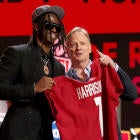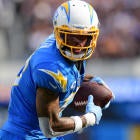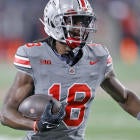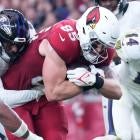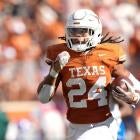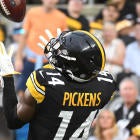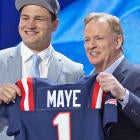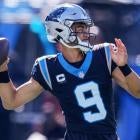If you ask me, the story of Fantasy football is defined by the breakouts. LaDainian Tomlinson and Christian McCaffrey are incredible, but when they hit on their biggest seasons, they were high-end first-round picks. Of course those were fantastic performances, but appreciating those seasons was and is materially different than the players that came out of nowhere.
When I think of Fantasy football history, the name I always think of first matches who I tend to hear first from others — Priest Holmes. What Holmes did after leaving the Ravens and heading to Kansas City to join Dick Vermeil's offense is nothing short of legendary in the Fantasy football world. Starting with his age-28 season when he had just under 2,700 career yards from scrimmage to his name, Holmes posted three straight seasons with more than 2,000 yards each, averaging more than 20 touchdowns per year in that span. Holmes was a breakout star, and anyone who rostered him in those years probably has a trophy gathering dust in a garage somewhere.
Those are the types of performances we'll focus on here. These players differ from one-year wonders in that they sustained some success after their breakouts, but their performances stand out because of the leap these players took that year. Let's take a look at some of the greatest breakout seasons in Fantasy football history, and how they helped spark some of the Fantasy stars we remember most fondly.
Running backs

Priest Holmes, 2001 and 2002
An undrafted five-year collegian out of Texas, Holmes ran for just 1,276 yards in his college career, which notably ended with him backing up sophomore Ricky Williams in his redshirt senior season. Already 25 years old in his second year with Baltimore, Holmes narrowly broke 1,000 yards and ran for 7 scores, a line that reads more impressive today than in the 1998 season in which it occurred, a year where Terrell Davis ran for more than 2,000 yards and 18 other backs also bested Holmes' 1,008.
Holmes wouldn't run for more than 600 yards in either of his next two years with Baltimore, suffering an injury in 1999 and backing up rookie Jamal Lewis in 2000, but he'd done enough to land a contract with the Chiefs.
And then, history. From 2001-2003, Holmes put together three straight seasons with over 2,100 yards from scrimmage. All three slot into the 50 best total yardage seasons in NFL history, but because he scored just 10 times in 2001, Holmes was more of a second-round Fantasy pick heading into 2002. That's when he truly emerged to Fantasy greatness with a career-high 2,287 total yards and 24 touchdowns in just 14 games. Finally the consensus top pick in 2003, he'd stretch his touchdowns to 27 in his age-30 season, and he was pacing for a similarly dominant 2004 campaign — over 1,000 yards, 15 touchdowns through eight games — before injuries cut short that season and, ultimately, the rest of his career.
But it was first 2001 and then 2002 when Holmes went from relative unknown to breakout star to "oh, wow, not only could he do that again, but he's now Superman."
Arian Foster, 2010
Another undrafted rookie who split time in college while at Tennessee, Foster didn't get on the field early in his rookie season in 2009 as Steve Slaton looked to build on his big 2008. But by midseason, Slaton was faltering, and Foster made his debut in Week 11 and eventually closed the year with more than 200 rushing yards and three scores in Weeks 16 and 17.
That gave Foster a fighting chance in the 2010 offseason, and Foster seized it — one of my lasting memories of Foster's 2010 was the preseason buzz, and how he seemed to go a round higher in every draft I did, until a leaguemate took him in I believe the fourth round of my final draft — a long-standing home league — and I didn't have Foster on a single team. I still haven't forgiven you, Kevin.
Of course, wherever Foster was drafted was irrelevant — he backed up all the hype and more, lapping the field as the clear RB1 in all formats with over 2,200 yards and 18 scores. Foster would go on to post three more top-six seasons, but none shined quite as bright as his 2010 breakout.
Tiki Barber, 2000 and 2004
It often seems like Barber's greatness is forgotten about, and that's at least in part because of how unique his career was. Always an undersized back, Barber had a limited role through his first three seasons, before he put up 1,725 yards from scrimmage and 9 touchdowns in 2000. That would have been a fine breakout, but it wasn't as elite in that era, and more importantly he fumbled nine times.
Barber would record 26 more fumbles over the next three seasons, at least eight times in each of four consecutive seasons, and it always seemed to hold him back from taking on a bigger role. Sure, in 2002 he got to 1,984 total yards and 11 scores, and finished as the RB5 in PPR formats. But Barber had never quite become elite, for that era, and his fumbles were always in part to blame.
Until he changed his grip, and everything clicked. In 2004, Barber got the fumbles in check, and he posted the RB1 season in PPR as a 29-year-old. That started a stretch of three 2,000 total yard seasons in the final three years of his career. In 2005, at age 30, he posted what was at the time the second best total yardage season ever, and to this day remains fourth. And incredibly, though he led the league that season with 411 touches, he fumbled just once.
Michael Turner, 2008
Turner's an interesting case, because expectations were plenty high when he joined the Falcons. After four years as LaDainian Tomlinson's efficient understudy, Turner landed a strong deal in free agency to take on a more prominent role. But in Atlanta, he was still expected to share the backfield with Jerious Norwood, who was himself ready for a larger role as Warrick Dunn's time with the Falcons had come to an end.
But it didn't go like that. Instead, Turner dominated the backfield and led the NFL with 376 carries, averaging more than 100 rushing yards and a rushing score per game with his 1,699 yards and 17 touchdowns. Sure, he caught a hilarious six passes all season, but that didn't stop Turner from finishing as the RB4 in PPR leagues; DeAngelo Williams and his 20 touchdowns just barely edged Turner for the top spot in non-PPR formats.
Turner would miss some time the next season, but came back in 2010 and 2011 with two more seasons of 1,300-plus rushing yards. And in all five seasons he spent with the Falcons, he ran for at least 10 touchdowns. But that 2008 season, his first in Atlanta, always stood as the best of his career.
Wide receivers
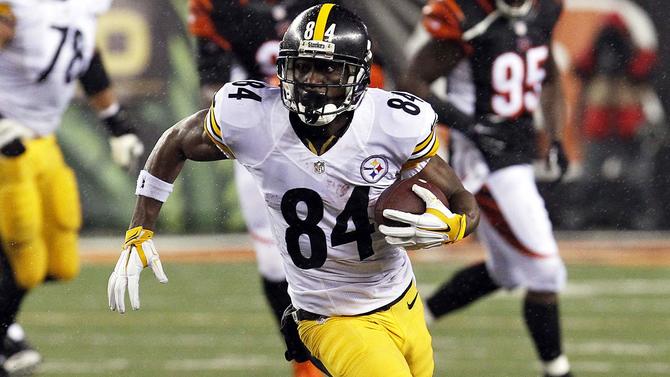
Antonio Brown, 2013
A sixth-round pick out of Central Michigan, Brown had already posted an 1,100-yard season by the time Mike Wallace left for greener pastures in the 2013 offseason. But that season had come in Brown's second year, in 2011, and he'd followed that up with just 787 yards in 13 games in 2012.
Thus, he entered 2013 with just over 2,000 receiving yards and 9 total touchdowns (two on returns) across the first three seasons of his career, a fine start to a career but one that gave no glaring indications he was on the cusp of an historic six-year run where he never failed to hit 100 catches, 1,200 receiving yards or 9 total touchdowns.
But in 2013, Brown emerged. His 110 catches on 167 targets for 1,499 yards and 8 scores made him the PPR WR3, and Brown wouldn't finish outside the top three again until 2018. Brown also added a punt return touchdown in 2013, something he'd do again in both 2014 and 2015.
Victor Cruz, 2011
An undrafted free agent out of UMass, Cruz quickly became a preseason star. Wearing jersey number 3, Cruz put up a line of six catches, 145 receiving yards and 3 touchdowns in the Giants first preseason game that year. He would add another 152 yards and a score in the Giants next three games, and while he was active for just three regular season games in that rookie season and didn't see a target, he broke camp in 2011 on the Giants' 53-man roster.
Cruz's season started slowly, with just two catches in the first two weeks, but in Week 3 he caught three of five passes for 110 yards and 2 scores, and he didn't look back. By the end of his second season, the salsa dancer had put up a line of 82-1536-9 on 131 targets, a nearly unfathomable rise that put him at WR3 for the season. He then became a Super Bowl champion, posting a 17-10-142 in New York's 3-point victory over San Francisco in the NFC Championship.
Cruz was WR14 in 2012 and WR28 in 14 games in 2013, so he didn't disappear completely, but that 2011 stood as far and away his best year and is one of the all-time great breakouts.
Marvin Harrison, 1999
Harrison was a first-round pick in the 1996 draft, so expectations were high. Through his third season, which was also Peyton Manning's rookie season, Harrison wasn't necessarily failing to meet those expectations — he was averaging 65 catches, 826 yards and 7 scores, but we weren't seeing the upside, as he had no seasons over 75 catches or 900 yards.
But 1999 — Manning's second year and Harrison's fourth — became a special year where this combination really started taking the league by storm. The Colts flipped their 3-13 record from 1998 to 13-3 as Harrison racked up 184 targets for a 115-1663-12 line. The next highest targeted Colts player was Edgerrin James with 82, and the next highest receiver sat at just 67.
That season, Harrison became the clear, no questions asked No. 1 option for the man who would go on to be one of the best quarterbacks of all time, and with that he began a stretch of four consecutive years as the overall WR1.
Miles Austin, 2009
An undrafted free agent out of Monmouth, Austin battled for three years to stay on the Cowboys roster. He caught five passes in his second season, and in his third year he caught just 13 balls, but for more than 20 yards per reception and three scores.
Heading into 2009, Terrell Owens was gone from Dallas, and Austin was moving up the depth chart. But after catching a 42-yard touchdown on one of just two Week 1 targets, Austin would see just one target in each of Weeks 2 and 3. In Week 4, Roy Williams went down, and Austin saw eight targets, but he turned those into just three catches for 19 yards. It wasn't until Week 5 when the breakout truly began, as Austin entered the starting lineup.
All Austin did in that road game in Kansas City was set the Cowboys all-time single-game receiving yardage record, turning 15 targets into 10 catches for 250 yards and two scores. He followed that up with an 8-6-171-2 line the very next week, and he would score six more times that season to finish with 11 touchdowns on 81 catches and 1320 yards. Despite his season starting slowly, he was the WR6.
Much like Cruz, Austin's breakout was his peak. He did follow it up with another 1,000-yard season in 2010 where he was the WR13, and he was solid in both 2011 and 2012 despite missing six games in 2011.
Quarterbacks
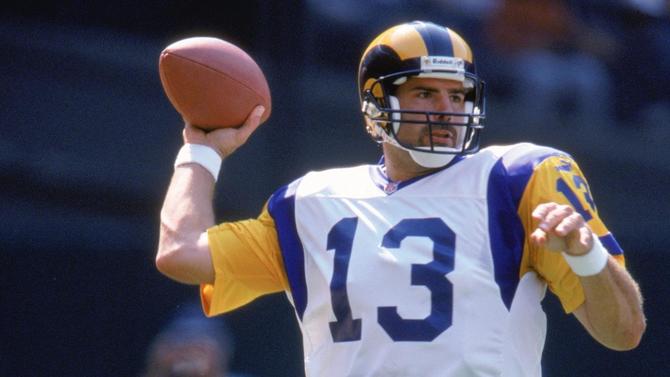
Kurt Warner, 1999
A 28-year-old backup from Northern Iowa who had only entered the NFL a year earlier after stints in the Arena League and NFL Europe, Warner was thrust into the starting role after Trent Green tore his ACL in the preseason. And thus was born The Greatest Show on Turf, with Warner leading the NFL with 41 touchdown passes and finishing 1999 as the overall QB1 for the 13-3 and eventual Super Bowl champion Rams.
Warner would miss five games in 2000 but bounced back to being the QB1 again in 2001, before playing just nine games across his final two seasons in St. Louis. Next it was off to New York for a year and then two as a backup/part-timer with the Cardinals before he finally found himself a clear starter again in Arizona in 2007. In 2008, his third and final 16-game season, he finished as the QB4 as a 37-year-old and took the Cardinals to the Super Bowl. Not a bad career.
Daunte Culpepper, 2000
There are several quarterbacks who could make this list, including Aaron Rodgers' first season as a starter in 2008 and Cam Newton rewriting the rules of rookie quarterback production in 2011. And in 2000, the only QB who Culpepper finished behind for Fantasy is another candidate in Jeff Garcia.
But Culpepper's breakout was pretty phenomenal in its own right, and after the first-round pick sat his rookie year in 1999 he went out and led the league with 33 touchdown passes in 2000. From there, he would miss five games in 2001, but go on to be the overall QB1 each season from 2002 through 2004 while slinging the ball all over the field for Randy Moss during some of Moss's best seasons as a pro.
Patrick Mahomes, 2018 and Lamar Jackson, 2019
I won't dwell here, but a list like this wouldn't be complete without recognizing how incredible these two breakouts have been the past two years. From an average draft position of QB15, Mahomes became just the second quarterback to throw for 5,000 yards and 50 touchdowns, while Jackson was QB17 and broke the all-time quarterback rushing yardage record. Both seasons are among the top four quarterback seasons in both total points and points per game since 1997.
Tight End
Rob Gronkowski, 2010 and 2011
A second-round pick out of Arizona, Gronkowski immediately showed off his touchdown-scoring ability by putting up 10 scores on just 59 targets and 42 catches to finish as the TE11 as a rookie. While that season came out of nowhere for a New England team that had rarely featured its tight ends, 2011 still couldn't have been expected.
What Gronkowski did in 2011 is unmatched in the history of the position. His 124-90-1327-17 season put him over 20 PPR points per game, and to this day no other tight end has ever hit 19. After those first two seasons, Gronk has yet to play 16 games in any other season, but that didn't stop him from scoring double-digit touchdowns in three more seasons to give him five total for his career to date.
Jimmy Graham, 2011
One of the all-time "former basketball players" at the position, Graham was a developmental prospect the Saints took in the third round in 2010. But after he worked his way into a solid second half that season, Graham also exploded in 2011, making it an all-time season for tight end breakouts.
In 2011, Graham set career highs with 149 targets, 99 receptions and 1,310 yards. He also scored 11 times, and while he finished TE2 due to Gronkowski's historic season, Graham would later have the second-best tight end season of all time in 2013 when he fell just short of the targets, receptions and yardage from his breakout season but found the end zone 16 times.













